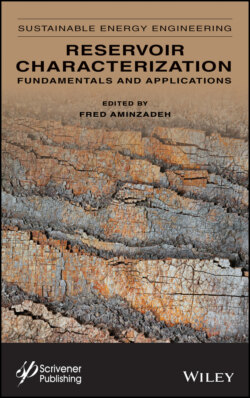Читать книгу Reservoir Characterization - Группа авторов - Страница 36
2.3 Laboratory Set Up and Measurements
ОглавлениеThe data used in this study were collected by a core flooding system at the laboratory of petroleum engineering department, Curtin University of Technology, Australia. The tested sandstone sample has the volume of 2.350 (gr/cm3), 3.79 cm in diameter, 7.98 cm in length and the porosity of 36/43 deg. After drying and preliminary preparation of this sample, it was placed in a polymer sleeve to be protected from the fluid axial pressure applied. The sample was placed inside the core holder, and piezoelectric (transducers) were placed on the caps to send and receive the acoustic wave. Figure 2.2 shows schematically, how the sample and exposure transducer were placed.
As seen in Figure 2.2, the enclosed sample is under Pr pressure (radial pressure) and axial pressure, Pax, is applied. In these conditions, the pore pressure is shown as Pp. In Figure 2.2, OD represents the outside diameter of the cap, ID represents the inside diameter of the cap, r is the core radius and Paxial is effective axial pressure that is calculated as in equation (2.16):
Figure 2.2 The placement of the test device is shown in schemati.
Different parts of this chamber which is in direct contact with the fluid, are neutral to chemical reaction. At the ends of this chamber, two caps are placed were the transducers have been installed. As seen in Figure 2.3, the receiver and transmitter are in direct contact with the sample.
The laboratory system is equipped with a back pressure regulator (BPR), to make it possible to simulate the behavior of real reservoir pressure. For axial and confining pressures, a hand pump has been used, and to achieve pore pressure, a hydraulic pump has been utilized. This test has been performed at room temperature. Signals are stored in a computer equipped with particular software which has the capability to integrate into the oscilloscope. Shown in Figure 2.4a is the complete flooding system device with three different fluid injection capsule, each with different kinds of fluids and the oven chamber that maintains the desired test temperature (46 °C in this experiment). Figure 2.4b indicates a picture of the core holder and connected transducers.
It should be noted that the injected fluid in this experiment is CO2 supercritical, which has been injected under 1300 psi pressure and a temperature of 46 °C at a rate of 1 (ml/min) into the sample saturated with distilled water.
Figure 2.3 Schematic, placement of sample with transducer and the top cap.
Figure 2.4 (a) The core flooding system, (b) Image of the holder connected to the core and transducers.
